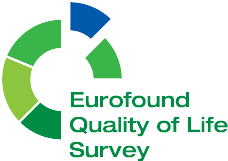
European Quality of Life Survey (EQLS)
Overview
Aims
The European Quality of Life Survey (EQLS) is a unique pan-European survey carried out every four years to examine the objective circumstances of European citizens' lives, and how they feel about those circumstances and their lives in general. It covers a range of subjects including employment, income, education, housing, family, health and work-life balance. It also looks at subjective topics, such as people's levels of happiness, how satisfied they are with their lives, and how they perceive the quality of their societies. By running the survey regularly, it has become possible to track key trends in the quality of people's lives over time using the EQLS.
Institution
European Foundation for the Improvement of Living and Working Conditions (Eurofound)
Geographic coverage - Nations
England, Scotland, Wales, Northern Ireland
Europe - 28 European Union Member states, 5 EU candidate countries (Albania, FYR Macedonia, Montenegro, Serbia, Turkey) (EQLS 2016)
Geographic coverage - Regions
Nationwide
Start date
2003
Catalogue record last updated
30/04/2025
Sample
Sample type
Repeated cross-sectional study
Sample details
In each wave a new sample of the adult population is selected randomly for a face to face interview. In view of the growth of the EU and interest from the EFTA countries, the geographical coverage of the survey has expanded over time.
The target population for each survey consists of all persons aged 18 who reside in private households in the country at the time of data collection. Those who have lived in the country for less than six months, cannot speak a language of the survey well enough to respond to the questionnaire or live in institutions are excluded.
For the EQLS 2016, a stratified, clustered, multi-stage sample design was used to select respondents. Random probability sampling procedures were used at all stages of sample selection for the project, and all members of the survey population had a known non-zero chance of being included in the sample. Depending on the availability of high-quality registers, sampling was carried out using individual-level, household-level and address-level registers or through enumeration using a random-walk approach. Country-level samples were stratified by region and degree of urbanisation. In each stratum, primary sampling units (PSUs) were randomly selected proportional to population size. Subsequently, a random sample of individuals or households was drawn in each PSU. Finally, unless individual-level registers were used, in each household the respondent was randomly selected. The sample was stratified by geo-administrative region and level of urbanisation.
Sample size at recruitment
1,000 (approx.) - UK sample, EQLS 2003
Sample size at most recent sweep
1,304 (UK sample) (2016 - EQLS 4)
36,908 (Total European sample) (2016 - EQLS 4)
Sex
All
Age at recruitment
18 years +
Cohort year of birth
Varied
Data
Data access
UK Data Service
eurofound.europa.eu/surveys/about-eurofound-surveys/data-availability
beta.ukdataservice.ac.uk/datacatalogue/studies/study?id=7348
Genetic data collected
No
Linkage to administrative data
No
Additional information
Website
eurofound.europa.eu/surveys/european-quality-of-life-surveys
Related themes
Housing,
Socioeconomic status and deprivation,
Loneliness and social isolation,
Neighbourhood,
Political and social attitudes,
Digital technology and social media,
Work and employment,
Social care - receipt,
Social care - provision,
Social care - need
Key Papers
European Quality of Life Survey 2016: Quality of life, quality of public services, and quality of society.eurofound.europa.eu/sites/default/files/ef_publication/field_ef_document/ef1733en.pdf
Mental health measures timeline
Sweep name:
Cohort member age:
Data collection period:
Notes:
Physical health measures:
